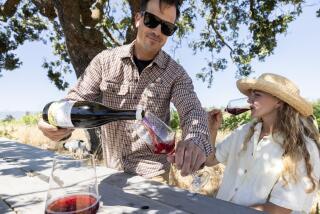Climate change could put the heat on California crops
- Share via
The Lockes have tilled the rich soil along the Mokelumne River since 1850. Now Chris Locke, 57, looks forward to passing down his orchards of 40,000 walnut trees to his four sons.
But the threat of global warming has him worried. “I talk to my boys about climate change,” he said. When he was young, frigid fogs rolled off the delta into Lockeford, the town named for his forebears. “We would go a week without seeing the sun. But we don’t seem to get that weather anymore.”
If San Joaquin Valley farmers such as Locke are fearful, so are the agricultural scientists who support California’s $10-billion annual fruit and nut crop, the largest in the nation. A new study from UC Davis, to be published today, found that the number of winter chilling hours, essential to the flowering of orchards, has declined as much as 30% since 1950 in large swaths of the Central Valley, where most of the tree crops are grown.
Only 4% of the Central Valley is now suitable for apples, cherries and pears, all high-chill fruits that could once be grown in half the valley, according to the study. By the end of the century, it says, “areas where safe winter chill exists for growing walnuts, pistachios, peaches, apricots, plums and cherries are likely to almost completely disappear.”
Winter chill hours could decrease 60% from 1950 levels by mid-century and by as much as 80% by the end of the century, according to the study.
“Climate change is not just about sea-level rise and polar bears,” said UC Davis researcher Eike Luedeling, lead author of the study. “It is about our food security. Climate change may make conditions less favorable to grow the crops we need to feed ourselves.”
The study comes amid a spate of reports predicting a decline in agriculture in California -- which produces half of the nation’s domestic fruits, nuts and vegetables -- as climate change affects water supplies and growing seasons.
The UC Davis study, which is to appear in the journal PLoS One, builds on a 2007 paper by UC Berkeley scientists Dennis Baldocchi and Simon Wong that predicted dramatic drops in winter chilling hours. But it expands on that research using a variety of climate models, and maps the expected changes in detail.
“These maps directly communicate the devastating effects of climate change on tree crops in California,” said co- author Minghua Zhang, a UC Davis professor of environmental and resource science.
Baldocchi endorsed the UC Davis study, remarking, “The irony is, just as the populace is getting more in tune with eating better, eating local, our wonderful fruit industry may be negatively affected.”
Some experts assume that the state’s agribusiness can adapt by breeding new varieties with lower chilling needs and by expanding the use of “rest breaking” chemicals that compensate for part of the trees’ lost chilling hours.
“Adapting is part of the game in agriculture,” said Jim Culbertson, head of the California Cherry Advisory Board, a marketing agency.
Scientists caution that adaptation could be expensive and difficult. “Orchards remain in production for decades,” Zhang said. “Growers must consider whether there will be sufficient winter chill to support the same tree varieties throughout their lifetime.”
Breeding new varieties requires genetic diversity, which is limited in some crops such as pistachios. In addition, low-chilling varieties of many fruits are vulnerable to frost, and rest-break chemicals raise safety issues, lead author Luedeling said.
To project winter chill, researchers used hourly and daily temperature records at 205 weather stations since 1950. They factored that data into 18 greenhouse gas emission scenarios for the 21st century, developed for the Intergovernmental Panel on Climate Change, a group of the world’s top climate scientists.
Traditionally, California farmers plant their crops by calculating the number of hours in which temperatures are expected to fall below 45 degrees Fahrenheit. The UC Davis researchers used that metric, as well as another model that measures a broader swath of temperatures. That second model shows a slower decrease in winter chill -- up to 60% from 1950 levels by the end of the century.
Some experts put little faith in predictions. “These chill models are so unsophisticated,” said Steve Southwick, a former UC Davis fruit science professor who now works for OG Packing, a major cherry and walnut distributor. “The way a tree behaves doesn’t much match what the models say, and the level of research on fruit trees is meager.”
Luedeling is concerned by what he sees as “not much preparation for these changes” in the agricultural community. “There’s not much breeding effort,” he said. “The main walnut breeder at UC Davis is retiring and after that, funding will be short.”
Meanwhile, Locke, the San Joaquin Valley farmer, figures his orchards’ chill hours have gradually sunk from about 1,500 a few decades ago, to about 1,000 to 1,200 today. He has made up for the drop by planting trees closer together and using new varieties, but he worries he may have to switch to other crops.
Few of his farmer friends have focused on global warming, Locke said. “A lot are conservative and don’t believe we are experiencing climate change. But we need to anticipate the future. I’m worried about the whole planet, not just our little ranch here.”
More to Read
Sign up for Essential California
The most important California stories and recommendations in your inbox every morning.
You may occasionally receive promotional content from the Los Angeles Times.







![Vista, California-Apri 2, 2025-Hours after undergoing dental surgery a 9-year-old girl was found unresponsive in her home, officials are investigating what caused her death. On March 18, Silvanna Moreno was placed under anesthesia for a dental surgery at Dreamtime Dentistry, a dental facility that "strive[s] to be the premier office for sedation dentistry in Vitsa, CA. (Google Maps)](https://ca-times.brightspotcdn.com/dims4/default/07a58b2/2147483647/strip/true/crop/2016x1344+29+0/resize/840x560!/quality/75/?url=https%3A%2F%2Fcalifornia-times-brightspot.s3.amazonaws.com%2F78%2Ffd%2F9bbf9b62489fa209f9c67df2e472%2Fla-me-dreamtime-dentist-01.jpg)






